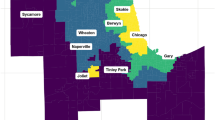Abstract
There is growing consensus that living in neighborhoods of concentrated poverty increases the likelihood of social problems such as teenage parenthood, drug and alcohol use, crime victimization, and chronic unemployment. Neighborhood inequality is also implicated in studies of enduring race/ethnic health disparities, and there are recent moves to broaden the definition of health care policy to policies targeting social inequality (Mechanic 2007). Residential segregation affects health outcomes in several different ways. First, income, education, and occupation are all strongly related to health (Adler and Newman 2002). Segregation is a key mechanism through which socioeconomic inequality is perpetuated and reinforced, as it hinders the upward mobility of disadvantaged groups by limiting their educational and employment opportunities. Second, segregation increases minority exposure to unhealthy neighborhood environments. Residential segregation creates areas with concentrated poverty and unemployment, both of which are key factors that predict violence and create racial differences in homicide (Samson and Wilson 1995). Neighborhood characteristics, such as exposure to environmental hazards, fear of violence, and access to grocery stores, affect health risks and health behaviors (Cheadle et al. 1991). Tobacco and alcohol industries also advertise their products disproportionately in poor, minority areas (Moore, Williams, and Qualls 1996). Finally, residential segregation leads to inequalitie in health care resources, which contributes to disparities in quality of treatment (Smedley, Stith, and Nelson 2002).
One strategy for reducing health disparities among ethnic groups, particularly among blacks and whites, would be to reduce or eliminate racial residential segregation and the corresponding geographic concentration of poverty. Currently, we have a number of programs in place that are designed, directly or indirectly, to affect the socio-demographic characteristics of neighborhoods (e.g., FHA low-income mortgage loans, Hope VI mixed income housing developments, and Section 8 housing vouchers). However, despite almost a century of neighborhood research, social scientists do not know what forces maintain segregation, what the respective strengths of these forces are, or how they combine. In the absence of theoretical and empirical knowledge of how segregation works, it is difficult to effectively evaluate the short-run effectiveness of policies, let alone their long-run equilibrium consequences. Moreover, without some understanding of the global impact of these housing policies, interventions may be ineffective, or worse yet produce unintended consequences that exacerbate problems of concentrated poverty. Examples of unintended consequences include the exploding crime rates in mid-sized cities which have been linked to the anti-poverty programs Hope IV and Section 8 (see Rosin 2008; Galster 2003; Bostic and Lee 2008).
Neighborhood formation and change is one example of a process in which collective dynamics emerge from the behavior of individual agents, mediated through interaction and aggregation. People who exit a neighborhood because they cannot tolerate its ethnic composition are both responding to and modifying neighborhood ethnic composition. This leads to a "spiral" or "domino effect" whereby small changes in neighborhood composition amplify and result in unexpected and extreme segregation. This is true even when people have relatively mild preferences for their own group (Schelling 1971, 1978). A number of health problems share these features of dynamic interdependence and feedback, including the spread of obesity, the development of drug-resistant strains of tuberculosis and Staph infections, and the recent increase in HIV infection rates following the development of more effective antiviral treatments (see La Berge 2008; Elford 2006; Fong and Drlica 2003; Palumbi 2001; Lightfoot et al. 2005). Existing methods for studying this type of process have not been successful in developing effective mechanisms for change. Such processes have been dubbed "policy resistant," as attempts at interventions often fail due to the response of the system to the intervention (Sterman 2006).
My work blends empirical, analytic, and computational methods in an effort to develop a body of theoretical knowledge and corresponding agent-based model that can identify a few mechanisms central to maintaining segregated neighborhoods. The model incorporates information about how individuals discover and evaluate potential destinations, the relationship between decisions about where to live and aggregate patterns of segregation, and an understanding of how policies aimed at reducing segregation affect mobility behavior. The research is iterative, with model validation providing clues into what might be misspecified or missing from the behavioral or agent-based models, resulting adjustments of the behavioral and agent-based models, and subsequent reevaluation. Provided the agent-based model can reproduce key features of neighborhood turnover in different cities, my hope is that it will be useful in the development and evaluation of alternative policies for reducing segregation. Along the way, the model will provide useful information including how people respond to their environment under conditions of change and uncertainty, the relationship between mobility patterns, economic inequalities among ethic groups, and racial segregation, how segregation dynamics scale with population size, and the effect of government interventions such as public housing and housing vouchers on mobility patterns and the housing market.
Access this chapter
Tax calculation will be finalised at checkout
Purchases are for personal use only
Similar content being viewed by others
Author information
Authors and Affiliations
Editor information
Editors and Affiliations
Rights and permissions
Copyright information
© 2010 Springer-Verlag Berlin Heidelberg
About this paper
Cite this paper
Bruch, E. (2010). Understanding Segregation Processes. In: Chai, SK., Salerno, J.J., Mabry, P.L. (eds) Advances in Social Computing. SBP 2010. Lecture Notes in Computer Science, vol 6007. Springer, Berlin, Heidelberg. https://doi.org/10.1007/978-3-642-12079-4_7
Download citation
DOI: https://doi.org/10.1007/978-3-642-12079-4_7
Publisher Name: Springer, Berlin, Heidelberg
Print ISBN: 978-3-642-12078-7
Online ISBN: 978-3-642-12079-4
eBook Packages: Computer ScienceComputer Science (R0)




